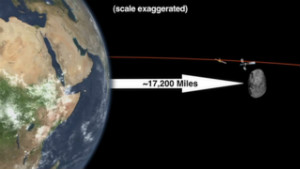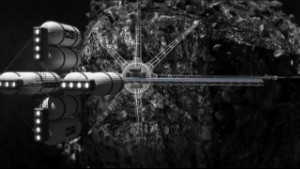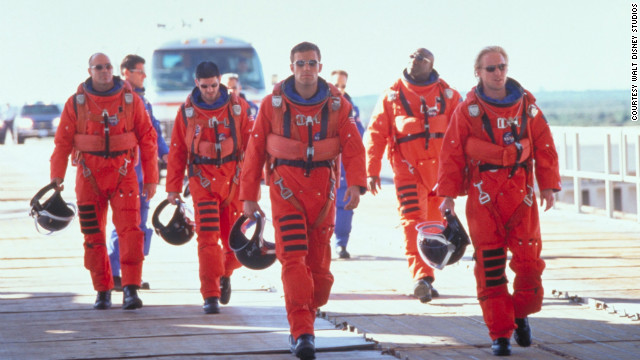So, about that asteroid near Earth ...
February 7, 2013 -- Updated 2257 GMT (0657 HKT)
STORY HIGHLIGHTS
- Asteroid will fly by Earth on February 15
- NASA: 9,672 objects have been classified as Near Earth Objects
- The OSIRIS-REx mission will take a sample from a different asteroid and bring it back
And this is only one of thousands of objects that are destined to one day enter our neighborhood in space.
"There are lots of
asteroids that we're watching that we haven't yet ruled out an Earth
impact, but all of them have an impact probability that is very, very
low," Don Yeomans, manager of the Near-Earth Object Program Office at NASA's Jet Propulsion Laboratory, said at a press briefing.
This particular asteroid is called 2012 DA14. NASA scientists reiterated Thursday that people have nothing to worry about.
"No Earth impact is possible," Yeomans said.
The asteroid is thought
to be 45 meters -- about half a football field -- long. It will come no
closer than 17,100 miles from our planet's surface.
An object the size of 2012 DA14 appears to hit Earth about once every 1,200 years, Yeomans said.
"There really hasn't been a close approach that we know about for an object of this size," Yeomans said.
On its close approach to
Earth, the asteroid will be traveling at 7.8 kilometers per second,
roughly eight times the speed of a bullet from a high-speed rifle, he
said.
If it were to hit our
planet -- which is, again, impossible -- it would collide with the
energy of 2.4 megatons of TNT, Yeomans said. This is comparable to the
event in Tunguska, Russia, in 1908. That asteroid entered the atmosphere
and exploded, leveling trees over an area of 820 square miles -- about
two-thirds the size of Rhode Island. Like that rock, 2012 DA14 would
likely not leave a crater.
 NASA: Don't fear asteroid passing Earth
NASA: Don't fear asteroid passing Earth
 Asteroid mining venture unveiled
Asteroid mining venture unveiled
Here's a comforting
thought: Meteorites enter the Earth's atmosphere all the time. About 100
tons of rocks come in from space every day, Yeomans said. They are
mostly small, from the size of a grain of sand to the size of a human
fist.
If you have a telescope
at least a few inches in diameter, you would see it as a small point of
light moving across the sky, said Timothy Spahr, director of the Minor
Planet Center at the Harvard-Smithsonian Center for Astrophysics.
You'll have to be
located in Eastern Europe, Asia or Australia for the best
telescope-aided view, scientists said. It won't be visible to the naked
eye.
What else is out there?
So, we know that this
particular asteroid isn't going to hit us, but how about all of those
other giant rocks floating nearby beyond our atmosphere?
NASA says 9,672 objects
have been classified as Near Earth Objects, or NEOs, as of February 5.
Near Earth Objects are comets or asteroids in orbits that allow them to
enter Earth's neighborhood.
There's an important
distinction between these objects: Comets are mostly water, ice and
dust, while asteroids are mostly rock or metal. Both comets and
asteroids have hit Earth in the past.
More than 1,300 Near
Earth Objects have been classified as potentially hazardous to Earth,
meaning that someday, they may come close or hit Earth. NASA is
monitoring these objects and updating their locations as new information
comes in. Right now, scientists aren't warning of any eminent threats.
Yeomans and colleagues
are using telescopes on the ground and in space to nail down the precise
orbit of objects that might threaten Earth and predict whether the
planet could be hit.
Observatories around the world send their findings to the NASA-funded Minor Planet Center, which keeps a database of all known asteroids and comets in our solar system.
NASA also has a space probe tracking asteroids to learn more about them. The Dawn probe was launched in 2007 and has already sent back dramatic pictures from the giant asteroid Vesta.
The spacecraft is now
heading to the dwarf planet Ceres. Dawn and Ceres are the two most
massive objects in the main asteroid belt.
A new asteroid adventure in 2016
A mission that's scheduled to launch in 2016 will teach scientists even more about asteroids.
OSIRIS-REx will visit an asteroid called 1999 RQ36, take a sample of at least 2.1 ounces and bring it back to Earth.
"This is going to be the
largest sample of an extraterrestrial object returned to Earth since
end of the Apollo missions over 40 years ago," said Edward Beshore,
deputy principal investigator for the mission, who is based at the
University of Arizona, Tucson.
The probe will arrive at the asteroid in 2018, study it, then bring back the sample in 2023.
1999 RQ36 is made of
materials "almost identical to those that were present when the solar
system was formed about 4.5 billion years ago," he said. That means
studying this asteroid could yield greater understanding about the
sources of organic molecules and water that gave rise to life.
This asteroid, like the
one that will fly by on February 15, is considered a near-Earth object.
The mission would further clarify the threat that this particular object
poses, and better predict the orbits of other near-Earth asteroids,
Beshore said.
Scientists at the University of Arizona are collaborating with NASA and Lockheed Martin Space Systems on this mission.
To better predict the
orbits of hazardous objects, this group is looking at the Yarkovsky
effect, a force created when the asteroid absorbs sunlight and
re-radiates it as heat.
The effect is, at first
glance, quite small -- Beshore cited his colleague Steven Chesley's
comparison of this effect to the force you feel when you hold grapes in
your hand. But over time, it's an important consideration when trying to
understand where an asteroid is headed.
"That force, applied over millions of years, can literally move mountains of rock around," Beshore said.
We can't say this enough: Don't panic over it.

 Asteroids and
comets are popular fodder for Earth-ending science fiction movies. Two
of the biggest blockbusters came out in 1998: "Deep Impact" and
"Armageddon." (Walt Disney Studios) Others include "Meteorites!" (1998),
"Doomsday Rock" (1997), "Asteroid" (1997), "Meteor" (1979), and "A Fire
in the Sky" (1978). Can you name others?
Asteroids and
comets are popular fodder for Earth-ending science fiction movies. Two
of the biggest blockbusters came out in 1998: "Deep Impact" and
"Armageddon." (Walt Disney Studios) Others include "Meteorites!" (1998),
"Doomsday Rock" (1997), "Asteroid" (1997), "Meteor" (1979), and "A Fire
in the Sky" (1978). Can you name others?
ไม่มีความคิดเห็น:
แสดงความคิดเห็น